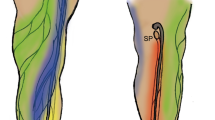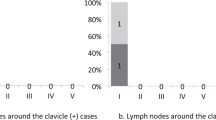Abstract
Oedema is a common finding in obesity and its cause is not always clear. Possible causes include impairment of cardiac, respiratory and/or renal function, chronic venous insufficiency and lymphatic problems. Lymphoscintigraphy is the best method to detect structural lymphatic abnormalities that can cause lymphoedema. We reviewed 49 female subjects with pitting oedema who had undergone lymphoscintigraphy, divided in three groups. The first group was comprised of severely obese patients in whom cardiorespiratory causes for oedema had been excluded. The second group consisted of non-obese patients with recognized causes for oedema and the third group was non-obese patients with ‘idiopathic’ oedema. A standard classification was used to interpret lymphoscintigraphy results. The frequency and severity of lymphoscintigraphic abnormalities was greatest in patients with clinical diagnoses of oedema related to ‘recognized causes’ (any abnormality in 50% of legs with obstruction in 22%). Obese patients and those with ‘idiopathic’oedema had fewer (P=0.02 for both) and milder lymphoscintographic abnormalities (any abnormality 32 and 25%, respectively, obstruction 5 and 3%, respectively), and although the clinical oedema was invariably bilateral, the lymphoscintigraphy abnormalities were usually unilateral. In conclusion, structural lymphoscintigraphic abnormalities are uncommon in obesity and do not closely correlate with the clinical pattern of oedema.
This is a preview of subscription content, access via your institution
Access options
Subscribe to this journal
Receive 12 print issues and online access
$259.00 per year
only $21.58 per issue
Buy this article
- Purchase on Springer Link
- Instant access to full article PDF
Prices may be subject to local taxes which are calculated during checkout
Similar content being viewed by others
References
Fife CE, Carter MJ . Lymphedema in the morbidly obese patient: unique challenges in a unique population. Ostomy Wound Manage 2008; 54: 44–56.
Ong HS, Sze CW, Koh TW, Coppack SW . How 40 kilograms of fluid retention can be overlooked: two case reports. Cases J 2009; 8: 33–34.
Movahed MR, Saito Y . Lack of association between obesity and left ventricular systolic dysfunction. Echocardiography 2009; 26: 128–132.
Saxena Y, Saxena V, Dvivedi J, Sharma RK . Evaluation of dynamic function tests in normal obese individuals. Indian J Physiol Pharmacol 2008; 52: 375–382.
Santiago-Recuerda A, Gómez-Terreros FJ, Caballero P, Martin-Duce A, Soleto MJ, Vesperinas G et al. Relationship between the upper airway and obstructive sleep apnea-hypopnea syndrome in morbidly obese women. Obes Surg 2007; 17: 689–697. Erratum in: Obes Surg 2007; 17: 996.
Luongo JA, Scalcione LR, Katz DR, Yung EY . Progression of clinically stable lymphedema on lymphoscintigraphy. Clin Nucl Med 2009; 34: 585–588.
Witte CL, Witte MH, Unger EC, Williams WH, Bernas MJ, McNeill GC et al. Advances in imaging of lymph flow disorders. RadioGraphics 2000; 20: 1697–1719.
Langendoen SI, Habbema L, Nijsten TEC, Neumann HAM . Lipoedema: from clinical presentation to therapy. A review of the literature. Brit J Dermatol 2009; 161: 980–986.
Rudkin GH, Miller TA . Lipedema: a clinical entity distinct from lymphedema. Plast Reconstr Surg 1994; 94: 841–847; discussion 848–849.
Tiwari A, Cheng KS, Button M, Myint F, Hamilton G . Differential diagnosis, investigation, and current treatment of lower limb lymphedema. Arch Surg 2003; 138: 152–161.
Scarsbrook AF, Ganeshan A, Bradley KM . Pearls and pitfalls of radionuclide imaging of the lymphatic system. Part 2: evaluation of extremity lymphoedema. Br J Radiol 2007; 80: 219–226.
Szuba A, Shin WS, Strauss HW, Rockson S . The third circulation: radionuclide lymphoscintigraphy in the evaluation of lymphedema. J Nucl Med 2003; 44: 43–57.
Pecking AP, Albérini JL, Wartski M, Edeline V, Cluzan RV . Relationship between lymphoscintigraphy and clinical findings in lower limb lymphedema (LO): toward a comprehensive staging. Lymphology 2008; 41: 1–10.
Khan O, Maharaj P, Rampaul R, Archibald A, Naipaul R, Loutan N . Lymphoscintigraphic evaluation of chronic lower limb oedema. West Indian Med J 2003; 52: 136–139.
Nawaz MK, Hamad MM, Abdel-Dayem HM, Sadek S, Eklof BG . Lymphoscintigraphy in lymphedema of the lower limbs using 99mTc HSA. Angiology 1992; 43: 147–154.
Gloviczki P, Calcagno D, Schirger A, Pairolero PC, Cherry KJ, Hallett JW et al. Noninvasive evaluation of the swollen extremity: experiences with 190 lymphoscintigraphic examinations. J Vasc Surg 1989; 9: 683–689; discussion 690.
Kleinhans E, Baumeister RG, Hahn D, Siuda S, Büll U, Moser E . Evaluation of transport kinetics in lymphoscintigraphy: follow-up study in patients with transplanted lymphatic vessels. Eur J Nucl Med 1985; 10: 349–352.
Ter SE, Alavi A, Kim CK, Merli G . Lymphoscintigraphy. A reliable test for the diagnosis of lymphedema. Clin Nucl Med 1993; 18: 646–654.
Vaqueiro M, Gloviczki P, Fisher J, Hollier LH, Schirger A, Wahner HW . Lymphoscintigraphy in lymphedema: an aid to microsurgery. J Nucl Med 1986; 27: 1125–1130.
Hall JE . The Kidney, Hypertension, and Obesity. Hypertension 2003; 41: 625–633.
Acknowledgements
We are grateful to the Hellenic Medical Association for Obesity for support of A-M V and KA.
Author information
Authors and Affiliations
Corresponding author
Ethics declarations
Competing interests
The authors declare no conflict of interest.
Rights and permissions
About this article
Cite this article
Vasileiou, AM., Bull, R., Kitou, D. et al. Oedema in obesity; role of structural lymphatic abnormalities. Int J Obes 35, 1247–1250 (2011). https://doi.org/10.1038/ijo.2010.273
Received:
Revised:
Accepted:
Published:
Issue Date:
DOI: https://doi.org/10.1038/ijo.2010.273
Keywords
This article is cited by
-
Brazilian guide to nutrition in bariatric and metabolic surgery
Langenbeck's Archives of Surgery (2023)
-
Lymphatic Tissue Engineering and Regeneration
Journal of Biological Engineering (2018)
-
Demonstration and Analysis of the Suction Effect for Pumping Lymph from Tissue Beds at Subatmospheric Pressure
Scientific Reports (2017)
-
Massive localized lymphedema: a clinicopathologic study of 46 patients with an enrichment for multiplicity
Modern Pathology (2016)
-
Pattern of Onset and Risk Factors for Peripheral Oedema During Vildagliptin Use: Analysis from the Vildagliptin Prescription–Event Monitoring Study in England
Drug Safety (2016)



